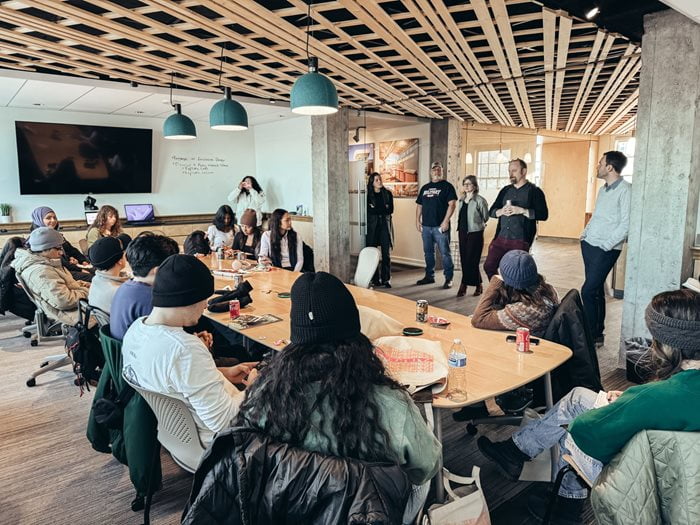Building an Equitable and Sustainable Future: Community Engagement and Design Collaboration in Alaska

Engaging students through community design has been a goal of the collaboration between the School of Architecture at CAPPA and the Anchorage Museum. Four 4th-year studios have partnered with the Museum (two in-person/travel and two virtual), focusing on river landscapes and climatic migration narratives in rural and urban Alaska. These studios featured on-site community engagement and fieldwork, virtual lectures, presentations, and project reviews with Alaska design firms, community members, and Museum leadership, including liaisons with Indigenous groups.
These initiatives set the stage for Spring 2025, which included advancing fieldwork during Anchorage Design Week in February. Modeled after an initial traveling studio in 2023, when CAPPA students visited Anchorage to participate in the Alaska Long Trail Symposium and conduct fieldwork during Anchorage Design Week, this iteration linked students to the ongoing Reconnecting Fairview project. The studio challenges students to integrate architecture and urban design solutions with broader cultural and ecological contexts, promoting environmental justice while supporting neighborhood and community development priorities.
This semester, the theme is Climatic Cartographies in the North and has invited local community members, design researchers, and studios to advance dialogue and positive visions supporting the ongoing Reconnecting Fairview project (led by NeighborWorks Alaska and the residents of Fairview) while considering the impacts of climate change on local systems. The project aims to support students in advancing remote and on-site research and developing conceptual solutions that reflect their engagement with Anchorage residents and organizations, including the Anchorage Museum, Anchorage Design Week, NeighborWorks Alaska, the University of Alaska Anchorage College of Community Engagement and Learning (UAA CCEL), and local grassroots organizations like the Fairview Community Council.

Before the trip, students analyzed the project context through physical modeling by giving form to agents/layers of data within the cartographic categories of density, infrastructure, and habitat. They collated these abstracted agents into a system by imagining their invisibility and temporality becoming visible and permanent upon the landscape. Models utilized depth, thickness, changes in material, construction method, hybrid media usage, etc., to create a spatial palimpsest that mapped and represented agents relative to their interdependence. Additionally, they modeled an armature that diagrammed potential site locations, adjacencies, access, and extensions into the context. Their proposed project programs were determined through community engagement and fall within one of the following categories: innovation/workforce development, world food market, healing/wellness, and ecotourism. The resulting architectural projects will be presented to the community after the semester after additional reviews with partners and designers in Alaska, with the potential to catalyze change in the neighborhood.

During the trip, they engaged in impactful community activities that deepened their understanding of the Fairview Neighborhood. They began with the Reconnecting Fairview Community Walking Tour, where their group walked alongside partner organizations and community members to gain firsthand insight into local issues. This was followed by the Reconnecting Neighborhoods Symposium, which featured presentations from various partner organizations actively involved in the community. Participants had the opportunity to share their work, fostering dialogue and collaboration with community members and stakeholders.
A highlight of their experience was an immersive workshop led by Kia Witherspoon, where they explored the interconnectedness of history, community, and design specific to Fairview. This session invited them to unravel the stories and legacies that shape the neighborhood's identity, emphasizing the importance of authentic, community-centered design. Additionally, they participated in a Northern Architecture Bus Tour, which took them beyond Anchorage into the mountains and valleys to observe various architectural conditions and strategies.


When discussing the role of the Anchorage Museum, Prof. Amanda Renee Aman expressed her deep appreciation for the incredible support provided by the Museum and its Chief Design Officer, Jonny. She stated, "They are in the weeds of the event organization, on the tours, and in the symposia with us, constantly connecting students with professionals and critical community members. They review student work on-site and join us for additional virtual reviews throughout the semester. They pull in many critical voices and truly understand the value of immersing students in a place and culture."
Engaging communities while co-generating design solutions is vital to imagining a more equitable and sustainable future. "Our partnership is ongoing! We partner on grant funding to support student travel and the event types listed above and are already beginning to plan 2026, including a possible summer program," she excitedly emphasized. The studio is eager to continue collaborating to foster long-term relationship-building and create inclusive environments.
